Federal Range & Field Ammo 22 Long Rifle Reviews
Review: Federal "Range Pack" Bulk-Packed 22 Ammo
06.01.17
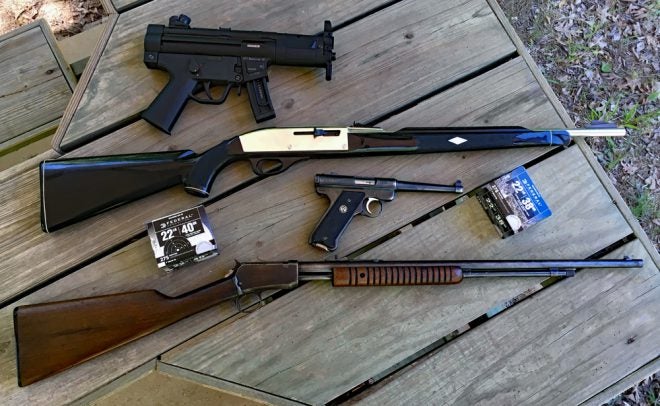
A few months back, I wrote about 2 new 22 LR loads from Federal Cartridge Co, which were being offered in bulk packs of 275 rounds. Well, I managed to get my hands on some and take information technology to the range with a few select firearms to come across how it does.
The ammo comes in two flavors: 40-grain atomic number 82 circular nose rated at 1200 FPS muzzle velocity, and 38-grain copper-plated hollow point rated at 1260 FPS. Naturally, the HP stuff is being marketed for hunting and the plainly lead bullets are intended more than for target piece of work.
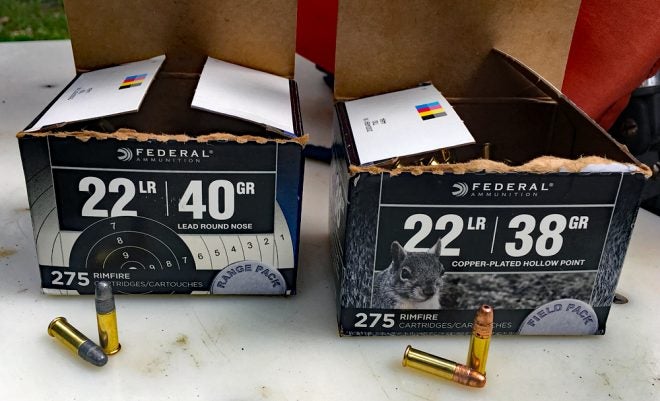
I decided to try both loads in two handguns and 2 rifles, all equipped with open up sights. For this job, I selected the post-obit:
- GSG-5PK semi-auto pistol, four.75″ butt
- Remington Nylon 66 semi-motorcar rifle, 19.5″ barrel
- Ruger semi-auto pistol, 6″ barrel
- Winchester Model 62A pump rifle, 23 one/eight″ barrel
I began by firing the rifles at 25 yards. I shot 15-round groups with each load in each burglarize, resting at a bench but zero fancy (just propped upwards the forend on a gun remainder).
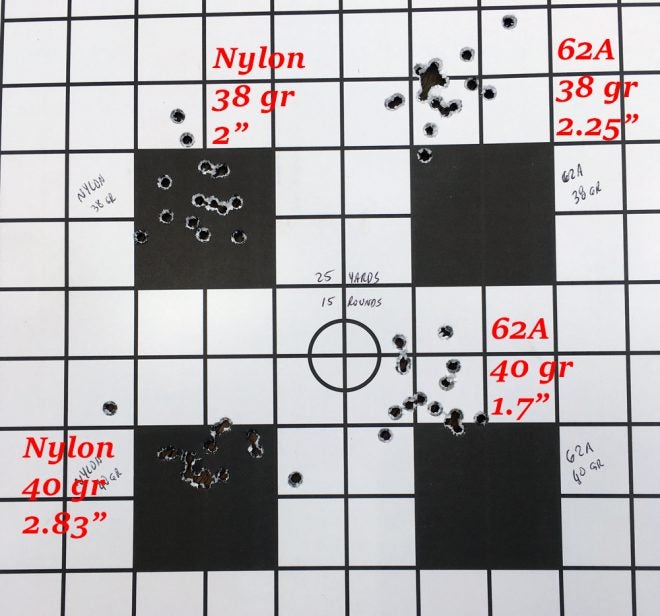
I wasn't bam-bamming away, merely I wasn't striving for super-tight groups, either. I'd say it was more of an average sit down-down-and-see-what-I-tin-do informal shooting session, which is what most folks are likely to do with bulk 22 ammo.
Every bit you can encounter, there's not much deviation between loads, although the 40-grain rounds arguably did a footling better, peculiarly if y'all disregard one or both of the flyers from the lesser left grouping.
Equally expected, I had no functioning problems with the rifles. The Remington Nylon 66 is an excellent little burglarize and is the virtually reliable 22 semi-auto rifle I take ever fired (with any ammo), and the old Winchester is a pump gun, most equally reliable an activeness as you can get.
Next, I moved on to the handguns.
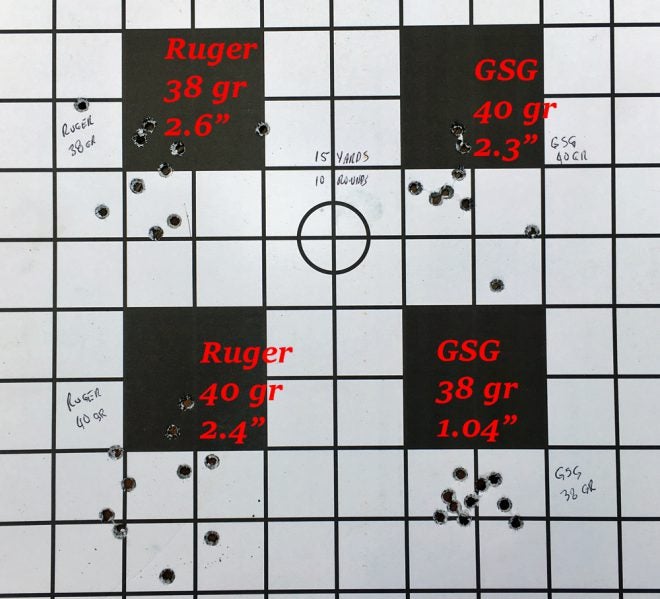
I fired iv 10-circular groups at 15 yards, once again resting but not to any farthermost. Accuracy was perfectly acceptable with the GSG giving my the tightest group, with the 38 grain HP bullets.
While firing these groups, the GSG did fine, just the Ruger hiccuped with the xl-grain ammo. Here'southward a picture show of the jam.
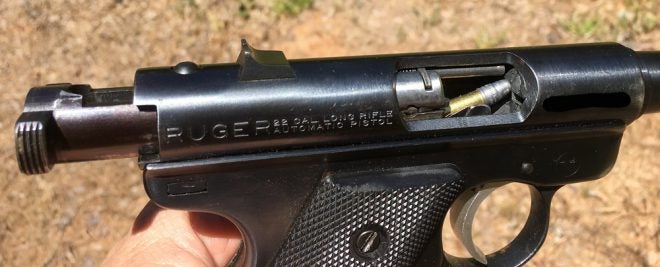
After firing at the newspaper target, I decided to fire sets of 10 aimed shots at a pocket-sized steel flipper target.
The GSG did well with the 40-grain ammo, merely the 38-grain groceries gave me some static. The gun failed to fire the second circular, and later on on I experienced this stovepipe:
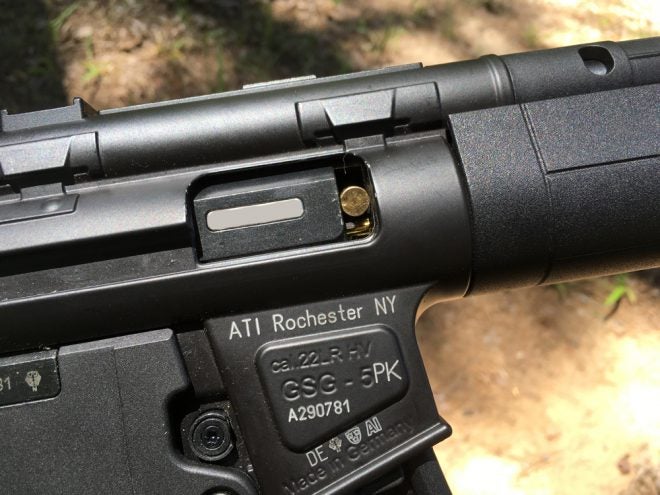
After this, I stoked up the GSG mag with 38-grain rounds and fired information technology rapidly. No problems. I repeated this test with forty-grain ammo in the same gun, and once more had no trouble.
I went back to the Ruger, firing aimed 10-shot strings. While I had no trouble with the 38-grain ammo, I did have two stovepipes with the 40-grain ammo. Both looked identical:
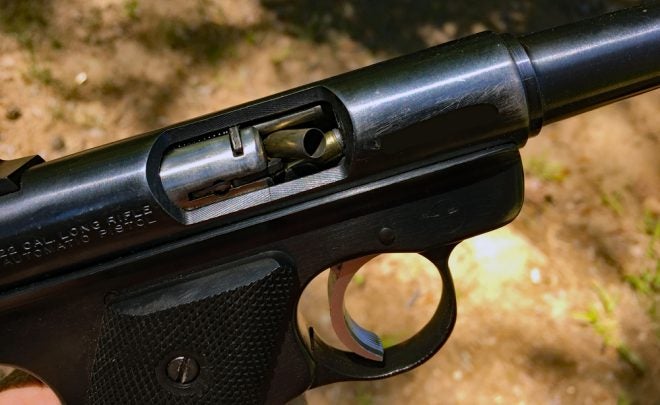
A rapid-fire test with the Ruger proved that while information technology likes the 38-grain ammo fine, the forty-grain loads cause indigestion. The third twoscore-grain round pulled this fox:
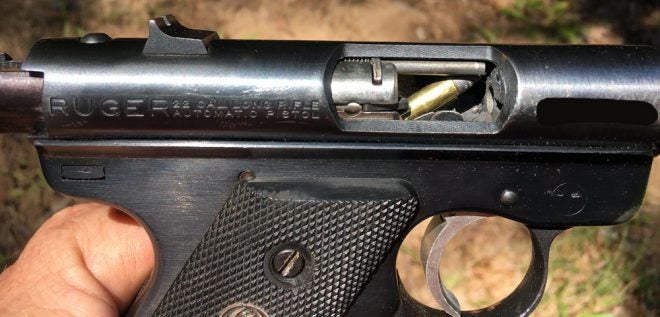
Conclusion
I like this ammo, but equally we have learned, not all of my poppers practise. The rifles I chose for this exam will assimilate simply about any 22 LR ammo, and I've never seen either one malfunction. The pistols also usually do well, just they didn't dear this ammo, particularly the Ruger with the 40-grain stuff.
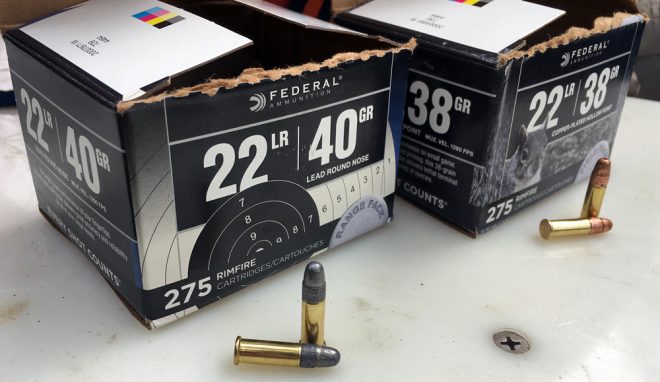
What to make of all this? Well, information technology'south bulk-packed 22 rimfire ammo, so it's not going to be the all-time ever. Referring to their claims as stated in my earlier postal service, is it more authentic than their older bulk-packed ammo? I don't know, simply it did fine for me, and I certainly found information technology more reliable than Federal majority-packed ammo used to be.
Federal also says the loads are ballistically matched and then you tin can aught your rifle with the Range load and look the same point of impact when hunting with the Field load. And comparing the centers of the groups I fired (38 vs 40 grain for each individual gun), the signal of impact thing is more than or less truthful.
The ballistic data on the boxes states that although muzzle velocity is rated differently (1200 for forty, 1260 for 38, the velocity, drop, and energy at 100 yards is identical.
Merely what caused the 40-grain groceries to disagree with the Ruger while the 38-grain stuff functioned perfectly? There'south really no way to know, but if I had to estimate I'd surmise that either the ammo is peradventure a bit "less hot" than the ballistic data indicates, and/or the copper plating on the 38-grain bullets made the difference.
Either way, this ammo represents a step forward in quality of bulk-pack 22 ammo, and that's a skillful matter.
Source: https://www.alloutdoor.com/2017/06/01/review-federal-range-pack-bulk-packed-22-ammo/
0 Response to "Federal Range & Field Ammo 22 Long Rifle Reviews"
Enregistrer un commentaire